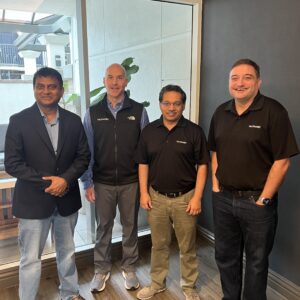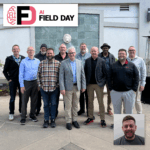|
|
 Vishal Sinha, Mike McGhee, Manoj Naik, and Alex Almeida presented for Nutanix at AI Field Day 7 |
This Presentation date is October 30, 2025 at 8:00-9:30.
Presenters: Alex Almeida, Manoj Naik, Mike McGhee, Vishal Sinha
Early AI projects fail due to infrastructure issues, not the AI itself. Nutanix offers a platform that simplifies AI infrastructure, allowing focus on data and models. Nutanix AI Data Platform offers unified services, radical simplicity, predictable scalability, and industry-leading performance. Nutanix Data Lens and Unified Storage provide intelligent, optimized, and secure storage for AI. The solution offers flexible deployment across edge, core, and public cloud.
The Enterprise AI Cloud Platform Powered by Nutanix Unified Storage
Watch on YouTube
Watch on Vimeo
At AI Field Day 7, Alex Almeida from Nutanix presented the company’s vision for enabling enterprise AI initiatives through a robust, cloud-native infrastructure built on Nutanix Unified Storage. He began by highlighting a critical industry insight: while interest in AI is surging, a reported 95% of enterprise generative AI pilots are failing to reach production. This widespread issue, he explained, is not due to deficiencies in the AI applications themselves but rather due to the lack of a strong, scalable data infrastructure that can support AI at the enterprise level. As companies attempt to scale pilots into production, the complexity of integrating data from edge, core, and cloud environments—along with difficulties in orchestrating networking, compute, and storage—presents a considerable barrier to adoption.
To address this challenge, Nutanix is focused on delivering a seamless platform that simplifies the infrastructure required for AI. Their solution is the Nutanix Cloud Platform, built on a modern server-based architecture with a focus on scalability, manageability, and consistency across compute, networking, and especially storage. This shift from traditional three-tier architectures to cloud-native technologies supports containerized applications and Kubernetes workflows. Nutanix sees its evolution from hyper-converged infrastructure (HCI) into a robust cloud-native platform as a foundational change that sets the stage for the next decade of enterprise computing, particularly for AI and PaaS environments. With components like Nutanix Kubernetes Platform (NKP) and Nutanix Cloud Clusters, organizations can run applications consistently across on-prem, cloud, and edge environments.
A central piece of this AI-ready infrastructure is Nutanix’s Unified Storage offering, which provides file, block, and object storage all integrated into a single platform. Almeida emphasized their data management capabilities through Nutanix Data Lens, which adds analytics and cybersecurity features such as ransomware detection. He also pointed to Nutanix’s strategic partnership with NVIDIA, underscoring their certified support for NVIDIA’s GPU Direct Storage and active involvement in NVIDIA’s Enterprise AI Factory. These collaborations ensure that Nutanix’s solutions are aligned with the latest AI data platform innovations. Overall, Nutanix aims to empower enterprises to overcome infrastructure hurdles and realize real ROI from their AI initiatives by providing a modern, unified data foundation.
Personnel: Alex Almeida
Enabling Data using Nutanix Unified Storage
Watch on YouTube
Watch on Vimeo
In their presentation at AI Field Day 7, Nutanix, represented by Distinguished Engineer Manoj Naik and SVP Vishal Sinha, laid out their vision for supporting AI workflows using Nutanix Unified Storage. They began by walking through a typical AI pipeline—from data ingestion and cleansing to model fine-tuning, inferencing, and archiving—emphasizing the challenges presented by data fragmentation across edge, cloud, and various formats. The Nutanix platform addresses these challenges by helping platform teams build and manage AI-ready data pipelines, ensuring clean, high-performance data is readily available for training large language models (LLMs) and inferencing operations.
The Nutanix solution includes a wide array of components that form a full-stack enterprise AI platform. Key pieces include Nutanix Cloud Infrastructure (NCI), Nutanix Unified Storage, the Nutanix Database Service (NDB), Nutanix Kubernetes Engine, and management layers such as Nutanix Central and Cloud Manager. Particularly noteworthy is their database management layer, which supports vector databases like PGVector and Milvus, enabling customers to manage LLM applications efficiently. The storage capabilities are tailored for each phase of the AI lifecycle—high-performance for training, rich metadata tiering for archiving, and versioning support via object storage and snapshotting.
The platform is designed to operate seamlessly across hybrid multicloud environments, offering data security, cyber resilience, and robust data mobility through features like global namespaces, immutable snapshots, and tiering based on metadata sensitivity. Nutanix Unified Storage supports multiple protocols (NFS, SMB, S3, iSCSI) and enables app and data colocation to optimize performance. The platform also supports cascading disaster recovery setups—including metro, asynchronous, and near-synchronous replication—to meet global compliance standards. With use cases ranging from edge AI inferencing to deep archival storage, Nutanix’s mature and versatile platform is built to handle the full lifecycle of data-intensive, AI-powered applications.
Personnel: Manoj Naik, Vishal Sinha
Nutanix Data Architecture and Safety
Watch on YouTube
Watch on Vimeo
In this presentation at AI Field Day 7, Manoj Naik from Nutanix outlined the underlying architecture of Nutanix’s unified data platform, which is designed to support next-generation AI workloads with high performance, security, and scalability. He began by analyzing traditional enterprise storage architectures—shared everything and shared nothing—and explained their inherent trade-offs. To overcome these limitations, Nutanix introduced a “shared flexible” architecture, combining the global accessibility of shared everything with the linear scalability of shared nothing. This allows for disaggregated yet cohesive compute and storage capabilities within a single cluster, enabling organizations to scale their infrastructure flexibly and efficiently.
Naik emphasized that the Nutanix platform is built around a data-first architecture, capable of handling the entire AI lifecycle from edge to core to cloud. It supports diverse protocols (NFS, SMB, S3) and applies smart data placement strategies through fine-grained metadata, intelligent caching, and protocol enhancements like SMB referrals and NFS v4. As data flows through the AI lifecycle, Nutanix ensures consistent operations and flexible mobility via replication, cloud integration, and unified control through Prism Central. The ability to scale both capacity and performance seamlessly—from single-node clusters to multi-petabyte, multi-cluster environments—positions Nutanix as a robust storage solution for AI pipelines and large-scale data lake infrastructures.
To validate its performance claims, Nutanix participated in ML Commons’ MLPerf Storage benchmarks, which simulate real-world AI workloads. Improved architectural paths, such as end-to-end RDMA, fast-path data transfers, and utilization of advanced features like SR-IOV, have allowed Nutanix to double performance while using half the hardware. Alongside performance, the platform includes comprehensive data protection features like snapshots, synchronous Metro replication, asynchronous DR, object locking, and integration with cloud object storage. This ensures both data resilience and compliance across deployment environments. Nutanix’s continued investment in performance optimization and robust data governance makes it well-suited for the demands of modern AI infrastructure.
Personnel: Manoj Naik
Data Mobility and Security with Nutanix
Watch on YouTube
Watch on Vimeo
At AI Field Day 7, Vishal Sinha of Nutanix presented the company’s comprehensive approach to data mobility and security in the context of AI and enterprise computing. He detailed how Nutanix facilitates seamless data movement across edge, core, and cloud environments by supporting various data operations such as synchronization, replication, and distribution. This data mobility capability allows for use cases such as consolidating data from edge locations to a central data center and then utilizing the cloud for AI model inferencing and tiered storage. The platform maintains a consistent global namespace, simplifying data management across disparate environments and enabling organizations to process, analyze, and store data efficiently regardless of location.
The focus then shifted to security, where Sinha emphasized Nutanix’s architecture as being inherently built with security in mind. The system features cyber-resilience measures that detect both known and novel ransomware threats using built-in file system logic and a behavioral-based detection engine. By continuously monitoring file activities and validating potential threats before alerting users, Nutanix minimizes false positives while maintaining an exposure window currently down to ten minutes, with plans to reduce it further. Integration with third-party security tools like CrowdStrike, Palo Alto Networks, and Splunk enhances the platform’s capabilities within broader enterprise security frameworks. Immutable snapshots and a powerful remediation engine further allow customers to take automated or manual action to protect their data and restore functionality with minimal downtime.
Further elaborating on the benefits to enterprises, especially within AI workflows, Nutanix offers Data Lens—a metadata analytics tool that provides full visibility and governance over data usage. This tool can trace file activity over time, identify anomalous user behaviors, and clarify permissions with bidirectional data access views. These capabilities improve compliance, auditability, and operational transparency. Nutanix’s philosophy centers around four foundational pillars: simplicity, security, ubiquity, and unification of storage formats. By delivering an integrated, software-defined storage platform that supports files, objects, and blocks, Nutanix enables organizations to build and maintain intelligent AI-driven applications while maintaining robust data governance and near real-time threat response.
Personnel: Vishal Sinha
Nutanix Data Lens Demo
Watch on YouTube
Watch on Vimeo
In the Nutanix presentation at AI Field Day 7, Mike McGhee showcased the capabilities of Nutanix Data Lens, a data analytics and cybersecurity tool designed to provide visibility across storage environments, including Nutanix file servers and third-party object stores like AWS S3. The tool collects and analyzes metadata—for example, file names, sizes, and data age—as well as real-time audit trails that track operations like reads, writes, and permission changes. Data Lens is tightly integrated with Nutanix storage solutions and will soon be bundled with their offerings for on-premises deployments, ensuring seamless operational data ingestion and monitoring without reliance on external scanning requests.
A major feature of Data Lens is its ransomware protection, which includes both signature-based detection using known file extensions from open source communities and behavioral analysis that identifies anomalous events like in-place or out-of-place encryption. This allows Data Lens to detect threats from unknown malware using intelligent algorithms trained on customer activity patterns. When threats are detected, Data Lens can log full user activity, block affected users or clients, and provide options for recovery that include restoring individual affected files or entire shares using recommended snapshots taken before the time of compromise. This detailed approach helps reduce false positives and accelerates recovery in the event of an attack.
In addition to its security functions, Nutanix emphasized the need for better tooling and data accessibility for platform engineering and end-users, particularly when supporting AI and DevOps workflows. Speakers stressed the importance of giving end-users API-level access to infrastructure components like databases, Kubernetes platforms, and AI services so they can manage and troubleshoot their workloads autonomously, without bottlenecks from IT. Nutanix’s broader ecosystem—including Nutanix Kubernetes Platform (NKP), Nutanix Database Services (NDB), and Nutanix AI (NAI)—was presented as a robust infrastructure solution with integrated observability and automation features designed to empower users and admins alike with actionable insights and streamlined management.
Personnel: Mike McGhee








